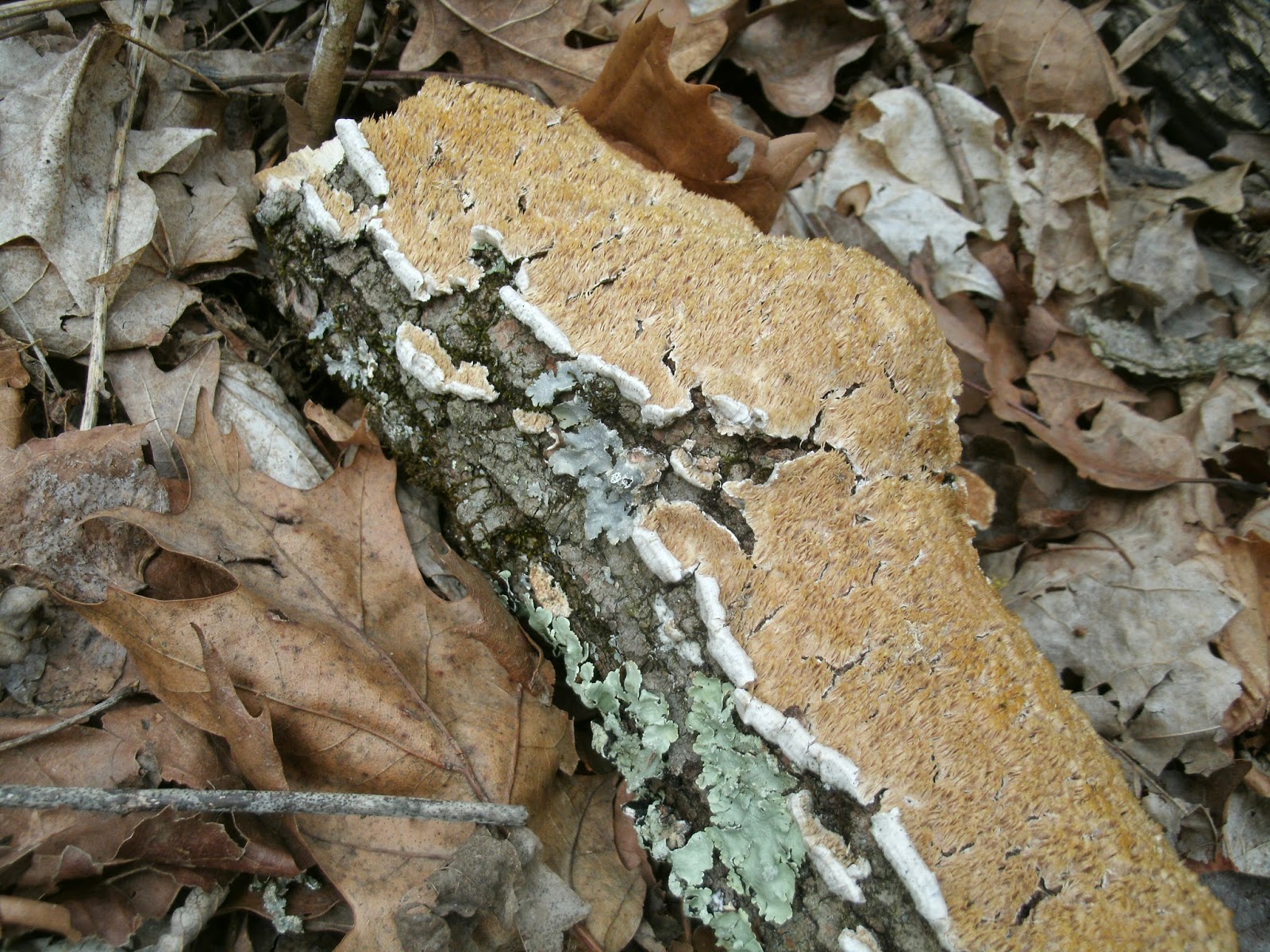Gouty oak gall on an oak tree at Celery Bog Park. These galls are caused by a Cynipid wasp, genus Callirhytis. Photo taken April 17, 2015.
Link to gouty oak gall wasps:
Link to Cynipid wasps:
Link to Callirhytis:
Tuesday, April 28, 2015
Irpex lacteus
The crust fungus Irpex lacteus on a fallen stick, in Happy Hollow Park, April 14, 2015.
Link to Irpex lacteus:
Link to Irpex lacteus:
Monday, April 27, 2015
Celandine poppy
Celandine poppy (Stylophorum diphyllum) in the woods at Cumberland Park, near the trail. This is the only one of these plants I saw in these woods. Photo taken April 21, 2015.
Link to previous post on Stylophorum diphyllum:
Link to previous post on Stylophorum diphyllum:
Link to previous post on Stylophorum diphyllum:
Link to previous post on Stylophorum diphyllum:
Antennaria
Antennaria at Murdock Park, near Ferry St. Probably Antennaria neglecta. Photo taken April 20, 2015. Just to the west of this site, along Ferry St., native shrubs (dogwood, hazel, and plum) were planted just before this photo was taken. The shrubs were planted to replace a growth of invasive Amur honeysuckle that the park department is trying to remove.
Link to previous post on Antennaria:
Link to previous post on Antennaria:
Sunday, April 26, 2015
Dutchman's breeches
Dutchman's breeches (Dicentra cucullaria) at Happy Hollow Park. A common spring wildflower in Indiana woodlands. Picture taken April 14, 2015.
Link to previous post on Dicentra cucullaria:
Link to Dicentra cucullaria:
Link to previous post on Dicentra cucullaria:
Link to Dicentra cucullaria:
Purple cress
Purple cress (Cardamine douglassii) at Happy Hollow Park between the main trail and Happy Hollow Creek. April 14, 2015.
Link to previous post on Cardamine douglassii:
Link to Cardamine douglassii:
Link to previous post on Cardamine douglassii:
Link to Cardamine douglassii:
Tuesday, April 21, 2015
Oil beetle
I noticed this huge bug crawling across the Duncan Hall parking lot in downtown Lafayette. Never saw anything like this but after looking into it I think it's an oil beetle. Meloe, possibly Meloe americanus. Interesting that these bugs feed on plants of the buttercup family. Most buttercups are poisonous or at least distasteful to humans and other animals.
Photo taken April 14, 2015.
Link to Meloe:
Link to Meloe americanus:
Link to oil beetles:
Photo taken April 14, 2015.
Link to Meloe:
Link to Meloe americanus:
Link to oil beetles:
Sunday, April 19, 2015
Cornelian cherry (Cornus)
This cornelian cherry tree (either Cornus mas or Cornus officinalis) is flowering in front of the old West Lafayette City Hall on Navajo St.
Cornelian cherry (Cornus mas or Cornus officinalis) in flower on Lindberg Road near Northwestern Ave.
Cornelian cherry can be easily confused with spicebush (Lindera benzoin) as both are small trees that show clusters of tiny yellow flowers at about the same time in very early spring. Spicebush is native to Indiana woodlands but sometimes is planted as landscaping. Cornelian cherry (Cornus) can be distinguished by the four petals on the tiny flowers. The bark of cornelian cherry has a mottled look and the twigs don't have the spicy aroma of spicebush.
Pictures taken April 13, 2015.
Link to Cornus mas:
Link to Cornus officinalis:
Link to previous post on cornelian cherry:
Cornelian cherry (Cornus mas or Cornus officinalis) in flower on Lindberg Road near Northwestern Ave.
Cornelian cherry can be easily confused with spicebush (Lindera benzoin) as both are small trees that show clusters of tiny yellow flowers at about the same time in very early spring. Spicebush is native to Indiana woodlands but sometimes is planted as landscaping. Cornelian cherry (Cornus) can be distinguished by the four petals on the tiny flowers. The bark of cornelian cherry has a mottled look and the twigs don't have the spicy aroma of spicebush.
Pictures taken April 13, 2015.
Link to Cornus mas:
Link to Cornus officinalis:
Link to previous post on cornelian cherry:
Sunday, April 12, 2015
Spicebush
Spicebush (Lindera benzoin) flowering on April 10, 2015. This spicebush is not growing wild but was planted next to the bird feeding area outside the nature center at Celery Bog Park.
Link to previous post on spicebush:
Another link to spicebush:
Link to previous post on spicebush:
Another link to spicebush:
Wednesday, April 1, 2015
Veronica polita is flowering
Link to previous post on Veronica polita:
Subscribe to:
Posts (Atom)











